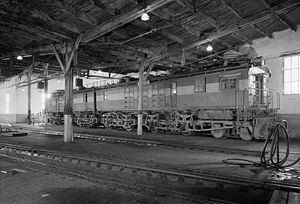
Boxcab
Encyclopedia

Locomotive
A locomotive is a railway vehicle that provides the motive power for a train. The word originates from the Latin loco – "from a place", ablative of locus, "place" + Medieval Latin motivus, "causing motion", and is a shortened form of the term locomotive engine, first used in the early 19th...
in which the machinery and crew areas
Cab (locomotive)
The cab, crew compartment or driver's compartment of a locomotive is the part of the locomotive housing the train driver or engineer, the fireman or driver's assistant , and the controls necessary for the locomotive's operation....
are enclosed in a box
Box
Box describes a variety of containers and receptacles for permanent use as storage, or for temporary use often for transporting contents. The word derives from the Greek πύξος , "box, boxwood"....
-like superstructure
Superstructure
A superstructure is an upward extension of an existing structure above a baseline. This term is applied to various kinds of physical structures such as buildings, bridges, or ships...
(from boxcar
Boxcar
A boxcar is a railroad car that is enclosed and generally used to carry general freight. The boxcar, while not the simplest freight car design, is probably the most versatile, since it can carry most loads...
). It is a term mostly used in North America
North America
North America is a continent wholly within the Northern Hemisphere and almost wholly within the Western Hemisphere. It is also considered a northern subcontinent of the Americas...
while in Victoria (Australia)
Victoria (Australia)
Victoria is the second most populous state in Australia. Geographically the smallest mainland state, Victoria is bordered by New South Wales, South Australia, and Tasmania on Boundary Islet to the north, west and south respectively....
, such locomotives have been nicknamed "butterboxes" (Victorian Railways
Victorian Railways
The Victorian Railways operated railways in the Australian state of Victoria from 1859 to 1983. The first railways in Victoria were private companies, but when these companies failed or defaulted, the Victorian Railways was established to take over their operations...
second series "E" Class electric locomotives numbered E1102 to E1111). Boxcabs may use any source of power but most are diesel
Diesel locomotive
A diesel locomotive is a type of railroad locomotive in which the prime mover is a diesel engine, a reciprocating engine operating on the Diesel cycle as invented by Dr. Rudolf Diesel...
or electric locomotive
Electric locomotive
An electric locomotive is a locomotive powered by electricity from overhead lines, a third rail or an on-board energy storage device...
s. Few steam locomotive
Steam locomotive
A steam locomotive is a railway locomotive that produces its power through a steam engine. These locomotives are fueled by burning some combustible material, usually coal, wood or oil, to produce steam in a boiler, which drives the steam engine...
s are so described but the SR Leader class
SR Leader Class
The Leader was a class of experimental 0-6-6-0T articulated steam locomotive, produced in the United Kingdom to the design of the innovative engineer Oliver Bulleid. The Leader was an attempt to extend the life of steam traction by eliminating many of the operational drawbacks associated with...
was a possible exception.
Boxcabs do not have heavily styled ends, or a superstructure consisting of multiple boxy structures, although the prototype diesel/oil-electric, GE #8835, had one prominently-rounded nose (from its trolley (tram
Tram
A tram is a passenger rail vehicle which runs on tracks along public urban streets and also sometimes on separate rights of way. It may also run between cities and/or towns , and/or partially grade separated even in the cities...
) car ancestry) and the second and following 100-ton ALCO boxcab
ALCO boxcab
The ALCO boxcabs were diesel-electric switcher locomotives, otherwise known as AGEIR boxcabs as a contraction of the names of the builders. Produced by a partnership of three companies, ALCO built the chassis and running gear, General Electric the generator, motors and controls, and Ingersoll Rand...
s had semi-cylindrical ends. Most American boxcabs date from before World War II
World War II
World War II, or the Second World War , was a global conflict lasting from 1939 to 1945, involving most of the world's nations—including all of the great powers—eventually forming two opposing military alliances: the Allies and the Axis...
, when the earliest boxcabs were often termed "oil-electrics" to avoid the use of the German name "Diesel".
Great Britain
Most British diesel and electric locomotives are boxcabs but the term "boxcab" is not used in Britain. Instead, locomotives are referred to by their class numbers, e.g. British Rail Class 47British Rail Class 47
The British Rail Class 47, is a class of British railway diesel-electric locomotive that was developed in the 1960s by Brush Traction. A total of 512 Class 47s were built at Crewe Works and Brush's Falcon Works, Loughborough between 1962 and 1968, which made them the most numerous class of British...
and British Rail Class 92
British Rail Class 92
The British Rail Class 92 is a dual-voltage electric locomotive which can run on 25 kV AC from overhead wires or 750 V DC from a third rail. It was designed specifically to operate services through the Channel Tunnel between Britain and France...
. British diesel and electric locomotives are nearly always double-ended (i.e. there is a cab at each end).

